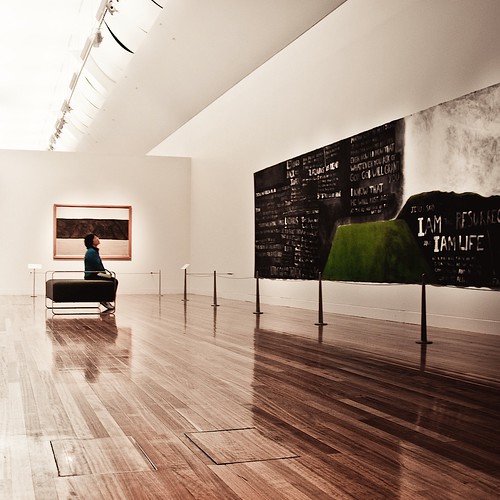 A colleague of mine approached me with a very serious question:
A colleague of mine approached me with a very serious question:
What can galleries do to acquire expected revenue? How does the traditional gallery adapt to 2013?
The thought of a gallery having expected revenue is almost laughable. People just don’t buy art like they used to. The creative world has (arguably) suffered the most since the 2008 – 2009 economic decline. Hundreds of galleries across the nation have closed down. When the government needs to cut back on spending, they usually trim the creative realms first. What gives?
The art world gives, and there’s danger to the decline. Gallery directors everywhere cringe and artists create in a silent kind of fear – the kind that says, “Yeah. I can’t make a living from my art.” It’s a quiet, barely noticeable identifying factor between artists when they get together at openings and other art-related functions. They all know the truth.
Even still, there’s hope – at least, for the galleries who can keep up. The economy will bounce back, and while it may never be as great as it used to be, when the economy begins to sit pretty again, the galleries who hung in there (and became innovators) will be top dogs. Galleries who want to survive should attempt to clear at least a few of these hurdles:
- Social Media – participating in the art conversation online is an absolute must. There’s a new generation of art leaders coming up, and galleries need to be able to adapt to that. If a gallery features a younger artist, and if that younger artists’ generation will become buyers one day, why wouldn’t you want to join social media? My social media recommendation(s)? Pinterest and Flickr and Instagram. They’re all visual, and that’s a huge marketing trend happening right now. Plus, there’s always the chance that an image you post could go viral.
- Dynamic Content – this is a marketing trend happening right now with enterprise business leaders. If you’ve ever been to Amazon.com, you’ll know what I’m talking about when I say “Your Recommendations”. If a potential customer clicks on a work of art to view it in detail, a gallery’s website could easily recommend works most like the one they clicked. Of course, you get into the knitty-gritty of “how do you commercially categorize art?” That’s not the goal here. The goal is to get your potential customer to keep perusing art and eventually sign up for a newsletter The other option is to use dynamic content in your article/news section of the website.
- Updated Marketing Campaigns – many galleries still operate in 1999 when it comes to marketing the gallery. Print isn’t always the answer, but it does have a relevant spot in the creative industry. People respond well to print media in the mail, and while it does bring in some people, it doesn’t always lead to conversions. Plus, it’s expensive! What if digital was the way to go? Let’s say a potential customer is perusing the website to look at an artist they’re thinking of investing in. This customer can click the artists name, see all of the images, and make a decision. Since there are no calls-to-action, the customer could just leave the website. How about prompting the customer for an email address in order to view work from Mark Karelson? Or Larry Walker? Soon, you have a database with potential customers’ email addresses and their names. BOOM. Send out a free newsletter and see how many conversions you can get. It’s related to customer relationship management (CRM) – and it’s valuable even to luxury industries like art.
- Event Space – galleries have s p a c e. That space can be rented out for weddings, parties, private events, even artists who need the studio space. Mason Murer is a perfect example of this. It’s a type of expected revenue they can pretty much always count on – especially when the art season gets rough. They have a huge, beautiful space, and they boast being the largest gallery in the Southeast.
- Real Estate – it’s time for galleries to think bigger than their tiny, tiny spaces. While it may be financially impossible for some galleries to open up an apartment complex or dormitory near a college, some start-up galleries could potentially accomplish this. People need places to live and would be willing to pay to live near a swanky gallery. Entering real estate with a trusted partner might not be a bad idea either.
- Experienced Sales and Marketing Hires / Consultants – galleries are limited by their revenue. It typically means a staff of maybe 5 or less employees. Well, they all might be able to hang art like a pro, but at least two of them should have sales, marketing, and arts administration experience. It’s a weird hybrid combination for a professional, but they do exist. I’m one of them. They should be able to keep up-to-date with new sales and marketing tactics, and also understand the way the art world works. A hybrid might cost more (or less depending), but it could be worth it if they pull in valuable leads. Keeping the gallery updated in how it markets itself will prevent it from being fossilized.
- Partnerships – it’s much more business related, but entering the gallery market with a partnership might be great for business – especially if they’re compatible units. The gallery business unit might be weak on its own, but if partnered with say, Starbucks or Barnes and Noble, suddenly the gallery is stronger. Partnerships are touchy, and depending on how it’s handled, might not be considered a “real gallery” – meaning it’s completely independent. Hats off to the galleries who have “made it”. For those looking to the future, a partnership could be the way to go to ensure some kind of survival.
